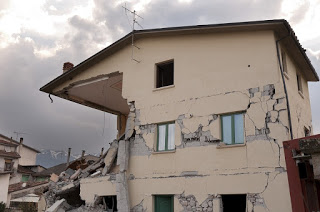Saad Iqbal | 🗓️Modified: October 18, 2016 | ⏳Read Time: 7 min | 👁Post Views: 953
You might have been to a beach or near a river bank, have you ever noticed the cohesion-less sands there? I am currently working in a project which is in a mountain range with river crossing through and is actually construction of a dam, during my travelling so many times
I have witnessed people that are, with the help of some bucket mounted on ropes, trying to extract the sand to use it in construction. Have you ever thought from where this cohesion-less soil comes from?
It is actually transported by layers of river due to its kinetic energy and inertia. So from here we can extract that if the soil is cohesion-less like sand and is fully saturated above its limit then it can flow like a liquid.
Definition of Soil Liquefaction
Liquefaction is a state of water- saturated, mostly cohesion-less soil whose shear strength is reduced to zero due to pore water pressure produced by vibration during an earthquake. The soil starts behaving like a liquid.
History of Soil Liquefaction
An American, Allen Hazen who was a consulting engineer and former vice president of American Society of Civil Engineers, in 1918 with reference to the failure of the Calaveras Dam has described, for the first time, the mechanism of soil flow liquefaction of the embankment dam.
 |
| Allen Hazen (1869 to 1930) |
Calaveras dam is a reservoir located in Santa Clara and Alameda, California, United States having catchment area of 255 square kilometers was built to fulfill the increasing demand for drinking water of the area. The first dam site which was built in 1913 suffered a partial collapse of the upstream slope in 1918 due to engineering flaws.
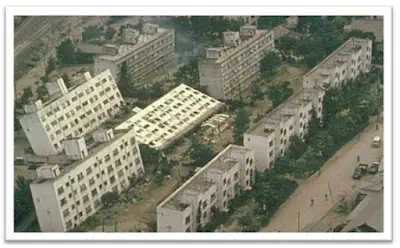 |
|
Some effects of liquefaction after the 1964 Niigata earthquake
|
Hazen explained and I quote that if the pressure of the water in the pores is great enough to carry the entire load, it will have the effect of holding the particles apart and of producing a condition that is equivalent to soil liquefaction.
Cohesion-less sandy soils (whose shear strength is only due to the inter-granular frictional force) have pores or empty spaces that after the application of load will compress and consolidate. These empty spaces in natural state are partially filled with water and sand. In saturated soils, the same pores are completely filled with water. If the load and stress is applied to a saturated cohension-less soil than the soil will consolidate upto a certain extent after which the water present in the pores will apply a buyout force, but further application of load will cause the water to escape the pores.
If the load is of repeated cycle dynamic in nature, like that of earthquake, than before the water can get the chance to escape, the soil due to pore-water pressure will get liquefied and hence will fail due to zero shear strength.
Relationship of Effective Stress and Pore Water Pressure
Now let’s investigate a situation to find out what actually makes the soil to flow like a liquid :-
Consider a soil element located at a distance ‘z’ from the ground surface as shown; if the Ground water is ‘h’ units below the ground surface than the effective stress on the soil particle would be : –
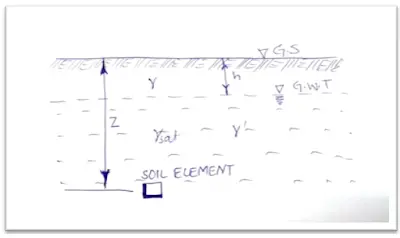 |
| Soil Liquefaction |
As shear strength of the soil is given by:-
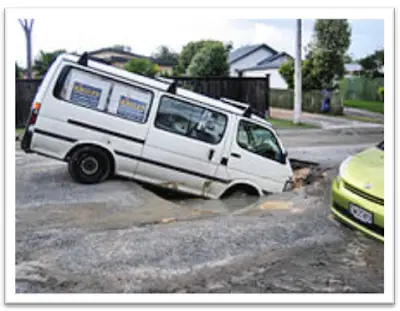 |
| Soil Liquefaction after 2011 Canterbury earthquake |
For cohension-less soil the cohesion c is zero thus;
The increase of pore water pressure will reduce the shear strength; if we take ud as the excess dynamic pore water pressure than the dynamic shear strength will be given by :-
The dynamic shear strength will be zero if :-
Thus this is proved that liquefaction in cohesion-less soil will occur when the dynamic pore water is equal to the effective stress.
On 17th October, 1989 a large scale destruction was caused by a 6.9 magnitude earthquake effecting the areas of California and San Francisco Bay Area, United States. In this earthquake surface faulting was not observed through a large number of other ground failures and landslides occurred especially in the Summit area of the Santa Cruz Mountains and the significant damage was also done by soil liquefaction especially near Marina District of San Francisco.
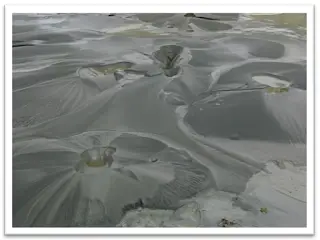 |
| Sand boils that erupted during the 2011 Christchurch earthquake |
Large settlements occur after liquefaction and the structures resting on such a soil deposit start sinking. This sinking process continues till the sand remains in the liquefied state.
Conditions of Liquefaction
Donald P. Coduto who is a professor of Civil Engineering in California State Polytechnic University has summarized five conditions which must be full filled for soil liquefaction to occur. Please refer to
Coduto Conditions of Liquefaction.
Sand Boils due to Liquefaction
One of a very common phenomenon observed after liquefaction of soil at shallow depth during an earthquake is called sand boil.
Types of Liquefaction
This classification of soil liquefaction is not that common however geologist and engineers have classified the soil liquefaction based on their effects in two types one is called Flow Liquefaction explained by Casagrande and other one is Cylic Liquefaction.
Effects of Liquefaction on Structures
The buildings and structures whose foundations are on soil affected by liquefaction will experience a sudden loss of support which will result in drastic and irregular settlement of the building causing cracking of foundations and damage to the building structure itself.
If the foundation of a building have a small layer of liquefied soil underneath than such a foundation will face punching shear type failure.
For more details on effects of liquefaction on different structures including buildings, structures, bridges, piles, embankments, utilities. Please refer to
Effects of Liquefaction on Structures.
Mitigation Measures for Soil Liquefaction
It is extremely difficult and impractical to prevent liquefaction of soil in the field when the susceptible zone extends to a large depth. It is generally best not to construct buildings and other structures at sites prone to liquefaction. Because the remediation of the liquefaction hazard is quite expensive, it would be cost effective only at the sites where the land cost is extremely high.
Remediation is sometimes necessary at sites that have been developed and the buildings already exist and later it has been found that the soil is prone to liquefaction. This generally happens when adequate site investigation were not prior to the construction of buildings.
Different methods like, Compaction of soil, providing deep foundations, Grouting the soil, Ground water pumping techniques are used for remedial measures of soil liquefaction. For more details refer to
Mitigation Measures for Soil Liquefaction.






